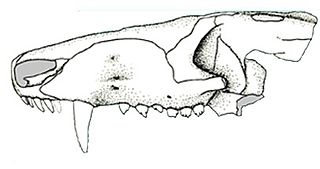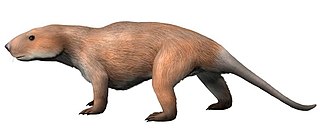
Xenorhinotherium is an extinct genus of macraucheniine macraucheniids, closely related to Macrauchenia of Patagonia. The type species is X. bahiense.

Prozostrodon is an extinct genus of probainognathian cynodonts that was closely related to the ancestors of mammals. The remains were found in Brazil and are dated to the Carnian age of the Late Triassic. The holotype has an estimated skull length of 6.7 centimetres (2.6 in), indicating that the whole animal may have been the size of a cat. The teeth were typical of advanced cynodonts, and the animal was probably a carnivore hunting reptiles and other small prey.

The Caturrita Formation is a rock formation found in Rio Grande do Sul, Brazil. Its sediments were deposited in the Paraná Basin. The formation is from the Upper Triassic and forms part of the Santa Maria Supersequence in the upper section of the Rosário do Sul Group.

Holmesina is a genus of pampathere, an extinct group of armadillo-like xenarthrans that were distantly related to extant armadillos. Like armadillos, and unlike the other extinct branch of megafaunal cingulates, the glyptodonts, the shell was made up of flexible plates which allowed the animal to move more easily. Holmesina species were herbivores that grazed on coarse vegetation; armadillos are mostly insectivorous or omnivorous.

Riograndia is an extinct genus of prozostrodontian cynodonts from the Late Triassic of Brazil. The type and only species is Riograndia guaibensis, named after the State of Rio Grande do Sul and Guaíba Basin, where it was discovered. Remains have been found in the Caturrita Formation of the geopark of Paleorrota. It was a small non-mammalian cynodont, with several advanced features also present in mammals. Several specimens of Riograndia guaibensis have been found in the towns of Candelária and Faxinal do Soturno in the Caturrita Formation. The genus defines the Riograndia Assemblage Zone.

The Sanga do Cabral Formation is an Early Triassic sedimentary rock formation found in Rio Grande do Sul, Brazil.

Catonyx is an extinct genus of ground sloth of the family Scelidotheriidae, endemic to South America during the Pliocene and Pleistocene epochs. It lived from 2.5 Ma to about 10,000 years ago, existing for approximately 2.49 million years. The most recent date obtained is about 9600 B.P.
Hoplitosuchus is an extinct genus of aetosaur. Fossils have been found from the Santa Maria Formation in Rio Grande do Sul, Brazil that date back to the Late Triassic. At first the genus was named Hoplitosaurus, but this name had previously been assigned to a polacanthine ankylosaurian dinosaur in 1902, thirty-six years before it had been referred to the aetosaur. Thus Hoplitosuchus was constructed as a replacement name for Hoplitosaurus. Because the holotype specimen consists of unidentifiable osteoderms and any other material attributed to the genus may actually be considered a composite of rauisuchian and dinosaurian remains, Hoplitosuchus is now considered to be a nomen dubium. The saurischian dinosaur Teyuwasu was named in 1999 on the basis of material originally attributed to Hoplitosuchus.
Protocyon is an extinct genus of large canid endemic to South and North America during the Late Pleistocene living from 781 to 12 thousand years ago.

Arctotherium is an extinct genus of the Pleistocene short-faced bears endemic to Central and South America. Arctotherium migrated from North America to South America during the Great American Interchange, following the formation of the Isthmus of Panama during the late Pliocene. The genus consists of one early giant form, A. angustidens, and several succeeding smaller species, which were within the size range of modern bears. Arctotherium was adapted to open and mixed habitat. They are genetically closer to the spectacled bear, than to Arctodus of North America, implying the two extinct forms evolved large size in a convergent manner.

Irajatherium is an extinct genus of cynodonts, known only of the type species Irajatherium hernandezi. It is named in honor of Irajá Damiani Pinto.
Barberenasuchus is an extinct genus of an archosauriform. Fossils have been found from the Santa Maria Formation of southern Brazil of Late Triassic age. Its phylogenetic position within Archosauriformes is uncertain; the author of its description classified it as a sphenosuchid crocodylomorph, while Kischlat (2000) considered it to be a rauisuchian. Irmis, Nesbitt and Sues (2013) stated that they "could not find any crocodylomorph character states preserved in the holotype specimen". Based on the presence of an antorbital fenestra the authors assigned Barberenasuchus to Archosauriformes, but stated that without further preparation and study it is not possible to assign it to any specific archosauriform group. It is named in honor of Mário Costa Barberena.

Proterotheriidae is an extinct family of litoptern ungulates known from the Oligocene-Late Pleistocene of South America. Members of the group were small-medium sized cursorial herbivores with brachydont teeth, with their toes showing progressive reduction, with later members of the group bearing weight on a single large toe similar to living horses.
Cordaicarpus is a form genus named by Geinitz (1862) and redefined by Seward (1917) to avoid confusion with another genus and to establish that the genus refers only seeds. Seward defined the differences between Cordaicarpus and Samaropsis.

Botucaraitherium is an extinct genus of prozostrodontian cynodonts from the early Norian Riograndia Assemblage Zone in the Candelária Formation of the Paraná Basin in southeastern Brazil. It is known from a single type species, Botucaraitherium belarminoi. The genus name is derived from the Botucaraí Hill, which dominates the landscape of Candelária, Rio Grande do Sul. The species epithet honors Belarmino Stefanello, a volunteer at the Museu Municipal Aristides Carlos Rodrigues, who found the fossil.

Neolicaphrium is an extinct genus of ungulate mammal belonging to the extinct order Litopterna. This animal lived from the Late Pliocene (Chapadmalalan) to the Late Pleistocene (Lujanian) in southern South America, being the last survivor of the family Proterotheriidae.
Rastosuchus is an extinct genus of stereospondyl temnospondyl within the family Rhinesuchidae. It contains one species, Rastosuchus hammeri, found in the Permian Rio do Rasto Formation of Brazil.
Macraucheniopsis is an extinct genus of litoptern mammal belonging to the family Macraucheniidae from the Middle to Late Pleistocene of Argentina. It, along with Macrauchenia, Neolicaphrium, and Xenorhinotherium were among the youngest known genera of litopterns.












